#war of 1812
Text
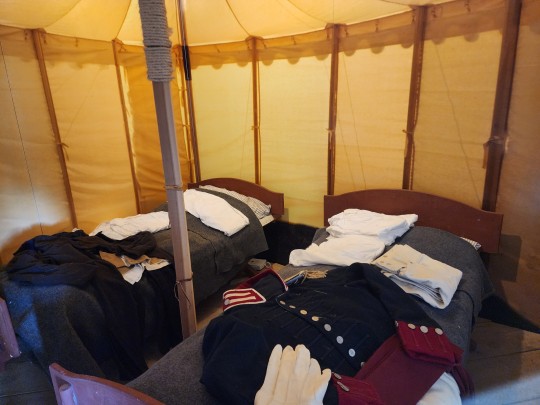
And there was only one tent for two officers' beds...
46 notes
·
View notes
Video
Pride of Baltimore II, July 2021
Video courtesy of Chief Mate Jeff Crosby
2K notes
·
View notes
Text
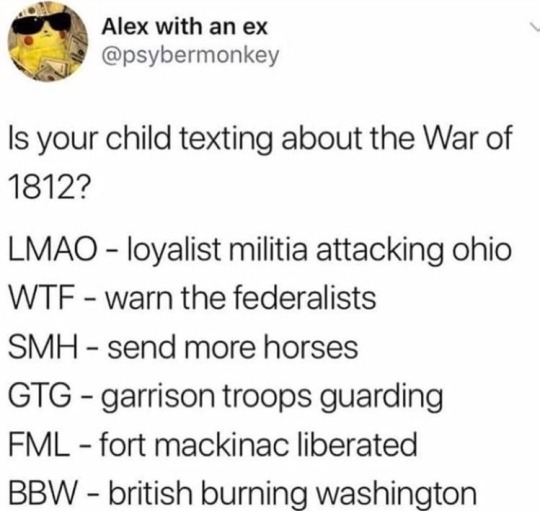
#history#war of 1812#haven’t seen this on tumblr yet but it’s making the rounds on Twitter#amhist#LOYALIST MILITIA ATTACKING OHIO
113 notes
·
View notes
Text
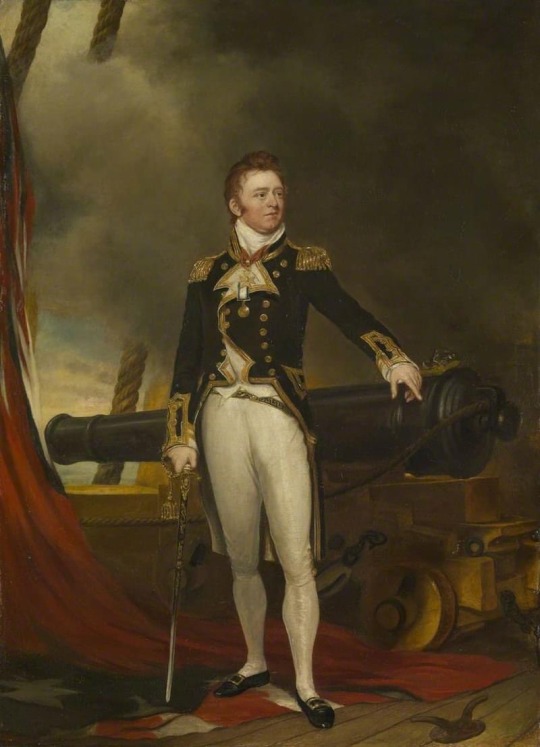
Captain Sir Philip Bowes Vere Broke, by Samuel Lane. During his lifetime, he was often referred to as "Broke of the Shannon", a reference to his notable command of HMS Shannon in the War of 1812. His most famous military achievement was defeating and capturing the American frigate, USS Chesapeake.
150 notes
·
View notes
Text
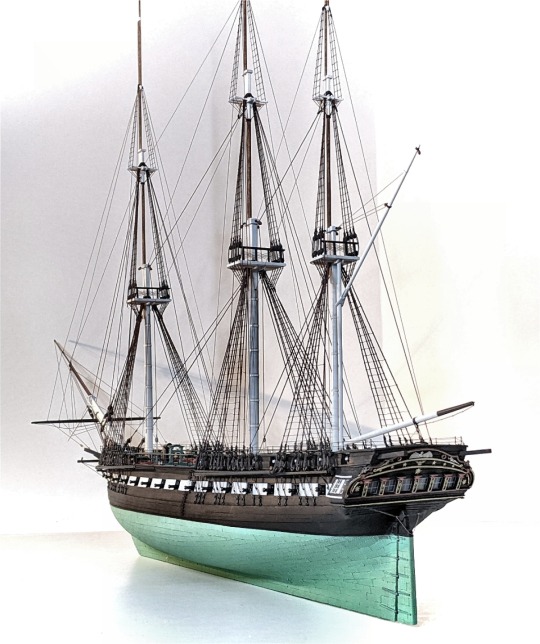
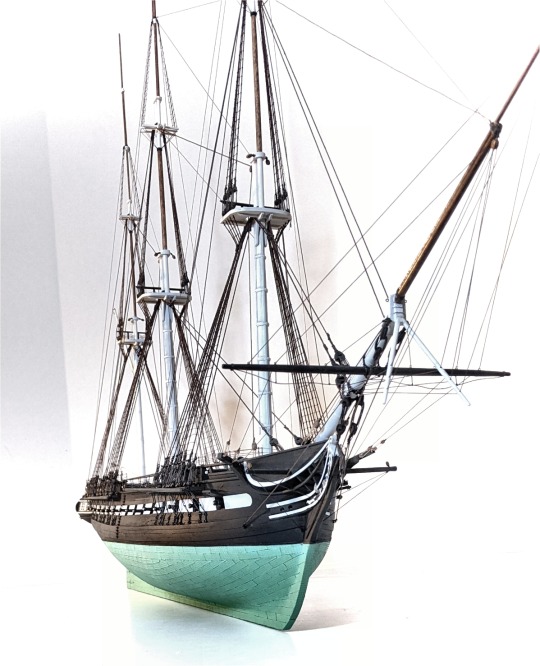
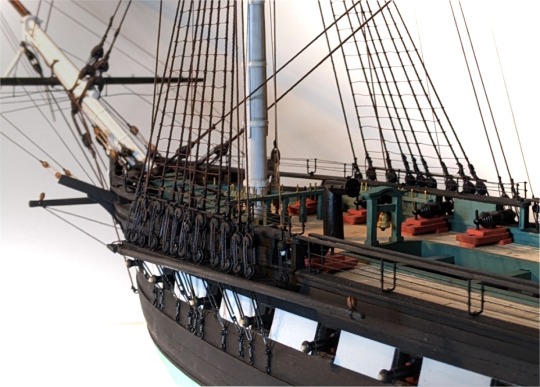
Project "Constitution c.1812" nearing her completion - yards and complementary running rigging to go!
#ship model#war of 1812#model design#cherry wood#scale model#constitution#model detail#custom models#custom model
58 notes
·
View notes
Text
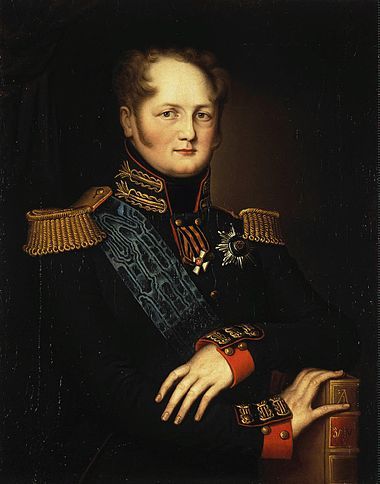
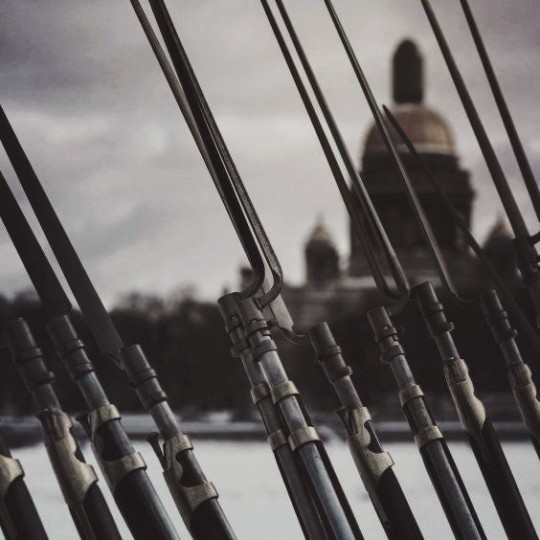
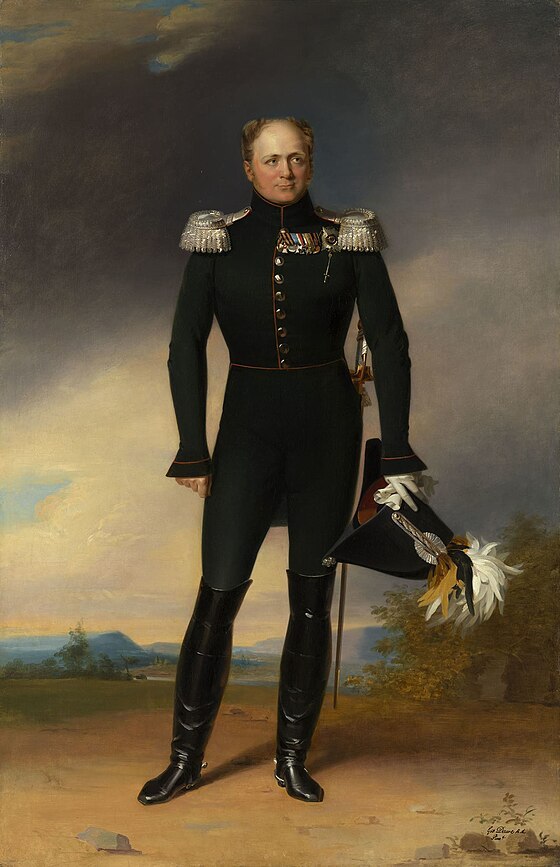



Кого я по-настоящему люблю и ценю, так это государя своего почтенного, Александра I. Готов выполнить любой его приказ. Да что приказ! За любимого своего государя готов на смерть идти!
Какое же это высокое и необъяснимое чувство un amour sincère et pur pour le puissant empereur
#war of 1812#19th century#война и мир#russian literature#nikolai rostov#alexander i of russia#alexander i#tsar alexander i#love#i love him#aesthetic
32 notes
·
View notes
Text
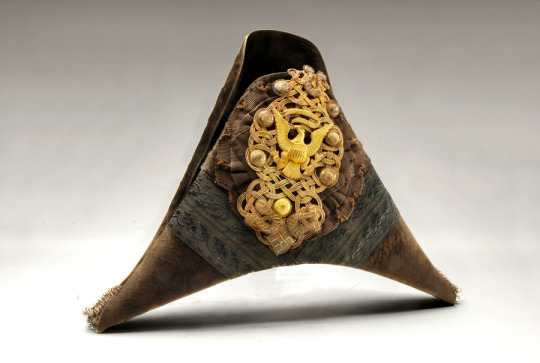

Hat, circa 1814
Military chapeau worn by Colonel Mendez I. Cohen (1796-1879) while he served as a member of Captain Nicholson's Company and General Armistead's command at the Battle of Fort McHenry in 1814. The triangular hat is decorated on the front with a gold emblem of an eagle with a shield, surrounded by gold braids and ribbons.
Courtesy of the Maryland Center for History and Culture
#hat#bicorne#napoleonic era#war of 1812#American history#history#American#fashion#military uniform#uniform#military#19th century#napoleonic wars#napoleonic#Maryland Center for History and Culture#fashion history#men’s fashion#mensfashion#menswear#1800s#1810s
249 notes
·
View notes
Text
Spicy Napoleon Opinions
Because with Ridley Scott's film coming soon, now seems like a good time to put them out there.
Napoleon betrayed the French Revolution. Sure, there's a school of thought that says that it probably needed to end, but if Napoleon had used his time as First Consul to defend France, achieve peace with Britain and then transition into a democracy - basically any form of democracy - he'd rightly be regarded as a hero of liberty and the enlightenment. Instead, in declaring himself Emperor, he fundamentally betrayed everything it stood for.
Napoleon lost any right to be considered 'enlightened' when he brought back slavery and walked back women's rights. Instead it took until 1848 (ironically, under the rule of his nephew, Louis-Napoleon, soon to be Napoleon III) for France to finally abolish slavery, over a decade after Britain.
Despite this, Napoleon was not Hitler. That's a common bit of hyperbole. What Hitler did was almost unique in history, in that he planned and executed an industrialised genocide right down to the train timetables. Napoleon, for all his faults, wasn't generally genocidal.
At worst, the wars between Napoleon and the Coalitions were between morally equal parties. By the time Napoleon invaded Spain, he was morally the worst of the two. The war of 1805-07 can at least be said to have been forced on France by Britain, Austria and Russia. This can't be said for the invasion of Spain and later of Russia, which were acts of naked aggression whatever the geopolitical rationale.
Napoleon would wipe the floor with Washington. It wouldn't even be close. I have no idea what Deadliest Warrior was thinking. (Then I realise they tried to argue that gatling guns were superior to machine guns and I remember they probably just fixed it in favour of the Americans.)
The Napoleonic Wars were won and lost in Spain. Okay, this is a bit hyperbolic, but the 'Spanish Ulcer' was a quagmire that deprived Napoleon of valuable reinforcements at critical moments and influenced his decision-making process in 1812 (leading to the Russian disaster.)
And while we're on this period...
Andrew Jackson might be the most overrated general in American history. Congratulations, you defended a fortified position against an enemy advancing frontally across a marsh. Bravo. Anybody could have done it, and that the Battle of New Orleans propelled such an odious figure to national prominence is a crying shame.
36 notes
·
View notes
Text
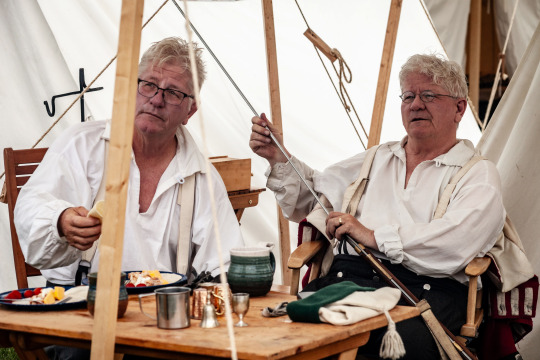


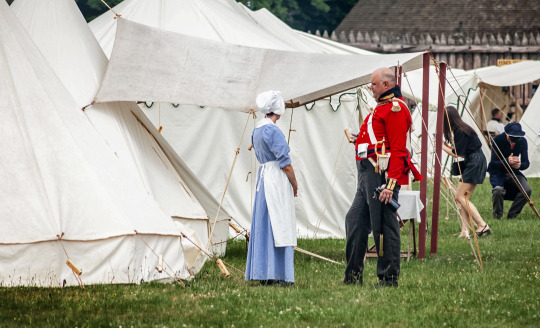
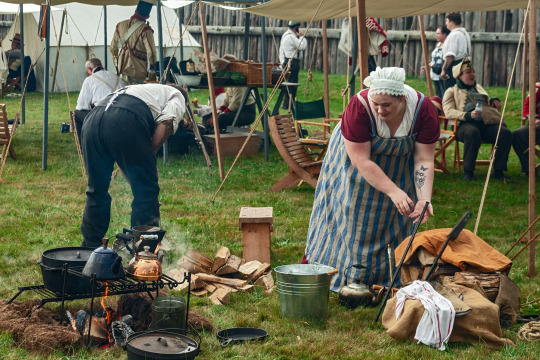
A very fun trip to Fort George this summer to see the 1812 reenactment. As I get older the camp life stuff and work in the kitchen becomes a lot more interesting than just the drill and soldiering (still fun). Met lots of great people and learned a lot of cool stuff.
#photography#mike wonnacott#photograph#uniform#photos#film#hamilton#fortgeorge#reenacting#reenactor#redcoat#redcoats#british army#british soldiers#musket#1812#war of 1812#cannon#niagara-on-the-lake#niagara#history#living history#history channel#loyalists#41st regiment#89th regiment#49th regiment#2nd york militia#fort york#ontario
34 notes
·
View notes
Text

"The original "Uncle Tom",
Rev. Josiah Henson and wife; Dresden ,Canada (c1907)
Josiah Henson (June 15, 1789 – May 5, 1883) was an author, abolitionist, and minister. Born into slavery in Charles County, Maryland, he escaped to Upper Canada (now Ontario) in 1830, and founded a settlement and laborer's school for other fugitive slaves at Dawn, near Dresden in Kent County. Henson's autobiography, The Life of Josiah Henson, Formerly a Slave, Now an Inhabitant of Canada, as Narrated by Himself (1849), is widely believed to have inspired the character of the fugitive slave, George Harris, in Harriet Beecher Stowe's Uncle Tom's Cabin (1852), who returned to Kentucky for his wife and escaped across the Ohio River, eventually to Canada. Following the success of Stowe's novel, Henson issued an expanded version of his memoir in 1858, Truth Stranger Than Fiction. Father Henson's Story of His Own Life (published Boston: John P. Jewett & Company, 1858). Interest in his life continued, and nearly two decades later, his life story was updated and published as Uncle Tom's Story of His Life: An Autobiography of the Rev. Josiah Henson (1876).
Josiah Henson was born on a farm near Port Tobacco in Charles County, Maryland. When he was a boy, his father was punished for standing up to a slave owner, receiving one hundred lashes and having his right ear nailed to the whipping-post, and then cut off. His father was later sold to someone in Alabama. Following his family's master's death, young Josiah was separated from his mother, brothers, and sisters.His mother pleaded with her new owner Isaac Riley, Riley agreed to buy back Henson so she could at least have her youngest child with her; on condition he would work in the fields. Riley would not regret his decision, for Henson rose in his owners' esteem, and was eventually entrusted as the supervisor of his master's farm, located in Montgomery County, Maryland (in what is now North Bethesda). In 1825, Mr. Riley fell onto economic hardship and was sued by a brother in law. Desperate, he begged Henson (with tears in his eyes) to promise to help him. Duty bound, Henson agreed. Mr. R then told him that he needed to take his 18 slaves to his brother in Kentucky by foot. They arrived in Daviess County Kentucky in the middle of April 1825 at the plantation of Mr. Amos Riley. In September 1828 Henson returned to Maryland in an attempt to buy his freedom from Issac Riley.
He tried to buy his freedom by giving his master $350 which he had saved up, and a note promising a further $100. Originally Henson only needed to pay the extra $100 by note, Mr. Riley however, added an extra zero to the paper and changed the fee to $1000. Cheated of his money, Henson returned to Kentucky and then escaped to Kent County, U.C., in 1830, after learning he might be sold again. There he founded a settlement and laborer's school for other fugitive slaves at Dawn, Upper Canada. Henson crossed into Upper Canada via the Niagara River, with his wife Nancy and their four children. Upper Canada had become a refuge for slaves from the United States after 1793, when Lieutenant-Governor John Graves Simcoe passed "An Act to prevent further introduction of Slaves, and to limit the Term of Contracts for Servitude within this Province". The legislation did not immediately end slavery in the colony, but it did prevent the importation of slaves, meaning that any U.S. slave who set foot in what would eventually become Ontario, was free. By the time Henson arrived, others had already made Upper Canada home, including African Loyalists from the American Revolution, and refugees from the War of 1812.
Henson first worked farms near Fort Erie, then Waterloo, moving with friends to Colchester by 1834 to set up a African settlement on rented land. Through contacts and financial assistance there, he was able to purchase 200 acres (0.81 km2) in Dawn Township, in next-door Kent County, to realize his vision of a self-sufficient community. The Dawn Settlement eventually prospered, reaching a population of 500 at its height, and exporting black walnut lumber to the United States and Britain. Henson purchased an additional 200 acres (0.81 km2) next to the Settlement, where his family lived. Henson also became an active Methodist preacher, and spoke as an abolitionist on routes between Tennessee and Ontario. He also served in the Canadian army as a military officer, having led a African militia unit in the Rebellion of 1837. Though many residents of the Dawn Settlement returned to the United States after slavery was abolished there, Henson and his wife continued to live in Dawn for the rest of their lives. Henson died at the age of 93 in Dresden, on May 5, 1883.
#Josiah Henson#Dresden#uncle tom#original uncle tom#american revolution#dawn township#kent county#methodist#preacher#tennessee#ontario#rebellion#dawn settlement#john graves simcoe#province#slaves#united states of america#united states#war of 1812#african#kemetic dreams#afrakan#africans#brownskin#afrakans#brown skin
66 notes
·
View notes
Text
I was reading Utmost Gallantry by Kevin D. McCranie and came across an intriguing line. When Captain Isaac Hull of USS Constitution was fleeing a British squadron in 1812, he passed within gunshot range of a British frigate, but the enemy held her fire. Hull later wrote that the frigate "did not fire on us, perhaps for fear of becalming her as the wind was light."
I immediately remembered that Frederick Marryat wrote something very similar about a ship's guns somehow stopping the wind, and found it in The King's Own: "wind lulled by the percussion of the air from the report of the guns."
This was apparently a genuine sailors' superstition!
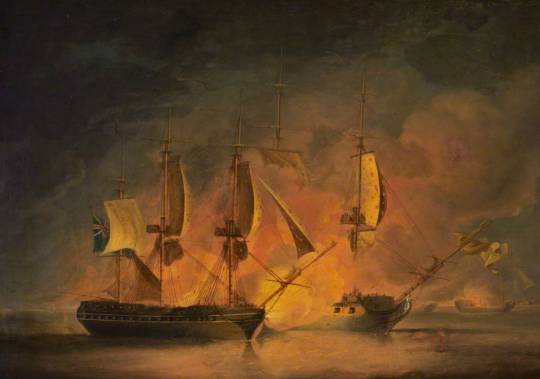
Action at Sea: an English and a French Frigate Engaging by Robert Dodd c. 1802 (ArtUK).
I searched Google Books for more references and found one in a late 18th century dispatch to the Admiralty quoted in Memoir of Robert, Earl Nugent: "their guns had so lulled the wind as to leave us little prospect of getting nearer to them."
I can see how, in an era long before smokeless powder, it might seem like firing large guns made the wind die down as the combatants were enveloped in clouds of smoke.
@ltwilliammowett have you heard this one?
#age of sail#sailors#superstitions#naval history#military history#maritime history#frederick marryat#war of 1812#naval battle#but you don't hear about ships firing their guns to quiet high winds!#do the guns lull the wind or not my dude#naval artillery
27 notes
·
View notes
Text

The Great Chase by Maarten Platje (1967-)
This depicts a scene in June 1812 when the USS Constitution was pursued by a far superior Royal Navy squadron in a flat calm and had to use her boats to tow herself clear.
452 notes
·
View notes
Note
This might be an absurd question to ask, but what type of ships were the Erebus and the Terror? I've recently had an interest in Polar Expeditions (particularly the ships themselves). I would look it up myself but I have a phobia of dead/decaying bodies and mummified people, and I am almost certain looking up "Franklin Expedition" would show images of the dead.
Thank you.
Hey there, friend! That's not an absurd question at all, and if you're at all uncomfortable with images of dead people, not searching "Franklin Expedition" online is probably a very wise decision.
HMS Terror and HMS Erebus were both bomb vessels, which in the 19th century Royal Navy meant full-rigged ships (three masts, square-rigged sail plan) made with extremely strong hulls to withstand the recoil of their weaponry—mortars that fired explosive shells, rather than cannons that fired more traditional shot. This type of weaponry was usually used for the bombardment of land-based targets, as in the famous bombardment of Fort McHenry during the War of 1812, in which Terror participated.
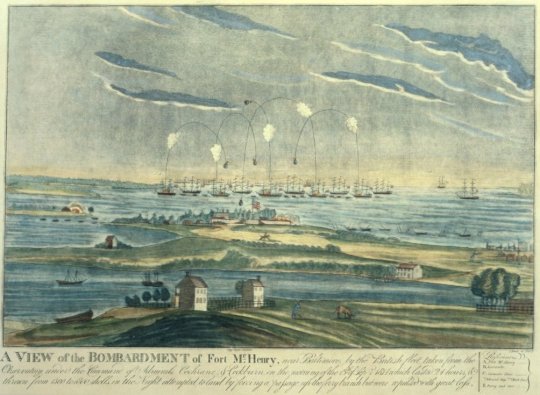
A View Of The Bombardment of Fort McHenry, © Public Domain.
The reinforced hulls that were made to withstand mortar recoil were also able to withstand (at least, to a certain degree) the immense pressure that would come with being icebound, so during the late 18th and early 19th century, bomb vessels were the preferred ships for polar exploration.
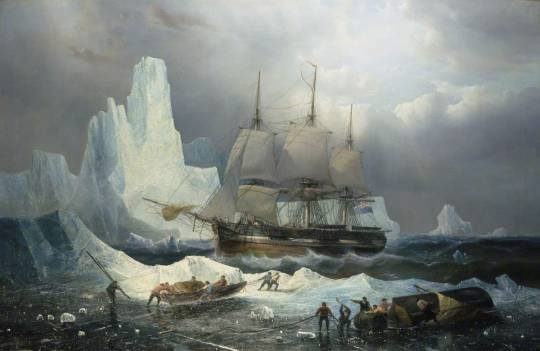
Erebus In The Ice, © François-Etienne Musin
Later polar expeditions tended to use whaling ships, like the Nimrod and the Terra Nova, or purpose-built polar exploration vessels, like the Endurance and the Fram. I hope this helps!
#ask#polar exploration#hms terror#hms erebus#franklin expedition#maritime history#royal navy#naval history#war of 1812#bomb vessels#nautical#19th century#the terror amc#definitelynothanna
52 notes
·
View notes
Text
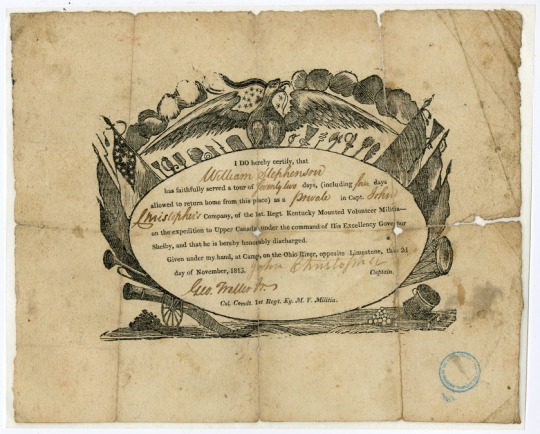
Bounty Land Application File of Private William Stevenson, Captain Christopher's Company, 1st Regiment of Kentucky Mounted Volunteers
Record Group 15: Records of the Department of Veterans Affairs Series: Bounty Land Warrant Application Files
Private William Stevenson’s discharge paper.
[illustration of early American eagle with military and civilian implements] I DO hereby certify, that [handwritten] William Stephenson [/handwritten] has faithfully served a tour of [handwritten] seventy two [/handwritten] days, (including [handwritten] four [/handwritten] days allowed to return home from this place) as a [handwritten] Private [/handwritten] in Capt. [handwritten] John Christopher's [/handwritten] Company, of the 1st Regt. Kentucky Mounted Volunteer Militia-- on the expedition to Upper Canada under the command of His Excellency Governor Shelby, and that he is hereby honorably discharged. Given under my hand, at Cap, on the Ohio River, opposite Limestone, this 2d day of November, 1813 [signed] John Christopher Captain [signed] Geo. Trotter Jr. Col. Comdt. 1st Regt. Ky. M.V. Militia
32 notes
·
View notes
Text

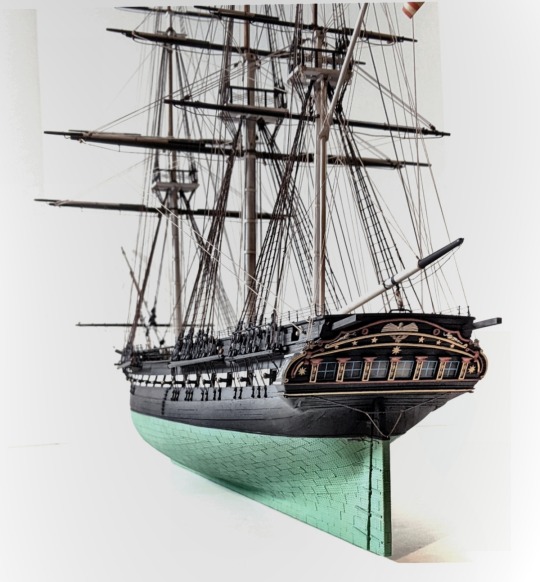
Almost done .... almost!
#ship model#custom model#war of 1812#constitution#the art of age of sail#scale model#model design#cherry wood
20 notes
·
View notes
Text
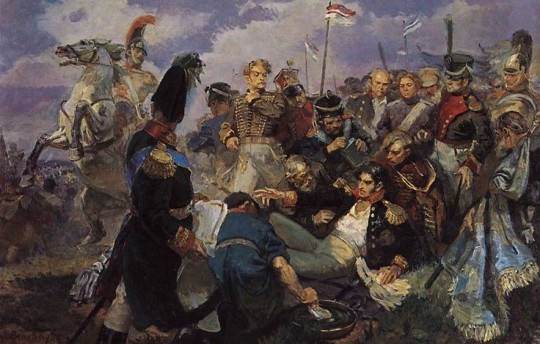



Теперь ли нам дремать в покое,
России верные сыны!
Пойдем, сомкнемся в ратном строе,
Пойдем — и в ужасах войны
Друзьям, отечеству, народу
Отыщем славу и свободу
Иль все падем в родных полях!
Что лучше: жизнь — где узы плена,
Иль смерть — где русские знамена?
В героях быть или в рабах?
1812г.
#painting#old paintings#war of 1812#19th century#война и мир#russian literature#napoleon bonaparte#nikolai rostov#poem#стихи#стихотворение#w&p#war and peace#napoleonic wars#aesthetic
13 notes
·
View notes